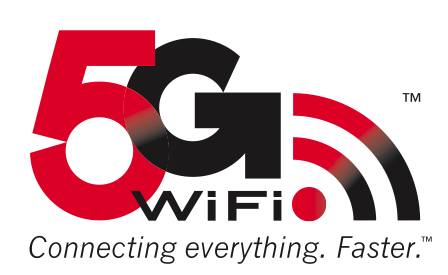Broadcom Announces Family of 802.11ac Chipsets & 5G WiFi Brand
by Anand Lal Shimpi on January 5, 2012 8:00 AM EST- Posted in
- Smartphones
- Networking
- Broadcom
- Mobile
- 802.11ac
- Tablets
If you've read our 802.11ac primer you already know that the fifth generation of WiFi is something to be excited about. At 433Mbps of bandwidth per stream with expected 1, 2 and 3 stream configurations to launch early this year, we should see a pretty big performance increase in transfer speeds on 802.11ac equipped devices. In order to get those devices however we'll need to see 802.11ac chipsets. As our luck would have it, today Broadcom is announcing the first four 40nm 802.11ac chipsets:
| Broadcom 5G WiFi 802.11ac Chipset Family | ||||||
| Chipset | Manufacturing Process | Interface | Spatial Streams | Max PHY Rate | ||
| BCM4360 | 40nm | PCIe 2.0 x1 | 3 | 1.3Gbps | ||
| BCM4352 | 40nm | PCIe 2.0 x1 | 2 | 866Mbps | ||
| BCM43526 | 40nm | USB 2.0 | 2 | 866Mbps | ||
| BCM43516 | 40nm | USB 2.0 | 1 | 433Mbps | ||
The BCM4360 is the highest end offering supporting three spatial streams and PHY rates of up to 1.3Gbps. The BCM4352 drops down to 2 spatial streams (866Mbps). Both of these chipsets are native PCIe 2.0 x1 and are targeted at client systems (e.g. notebooks, add-in cards) as well as wireless access points.
The BCM43526 is a USB 2.0 version of the 4352, again supporting two spatial streams. Broadcom is expecting some of its customers to bundle 43526 based USB sticks with their 802.11ac wireless routers/APs. Finally there's the BCM43516, another USB 2.0 based design but with support for only a single spatial stream (433Mbps).
All of the 802.11ac chipsets support 80MHz channels and 2.4GHz fallback to 802.11b/g/n.

Broadcom is also launching a new brand for its 802.11ac devices: 5G WiFi. The brand and logo are available to Broadcom's customers (not competitors) with no financial requirements, although they obviously have to use one of these Broadcom 802.11ac chipsets.
Note that although smartphone and tablet vendors could use these 802.11ac controllers in their devices, they aren't the intended target. We will see SDIO/HSIC based 802.11ac controllers from Broadcom at some point the future.
You can expect to see the first 802.11ac devices based on these chipsets next week at CES.










7 Comments
View All Comments
DigitalFreak - Thursday, January 5, 2012 - link
I don't even see a point to the BCM43526. It's USB 2.0, yet has a wireless transfer rate of up to 866Mbps? Even the 43516 is iffy.quiksilvr - Thursday, January 5, 2012 - link
It's 2 spatial streams so its usb 2.0 x 2.jing0201 - Monday, February 6, 2012 - link
Do you mean that will have 2 port of USB?dagamer34 - Thursday, January 5, 2012 - link
I'd expect then to make USB 3.0 versions soon. But heck, even 2.0 versions would be faster if you got 300Mbps in real world speed.zorxd - Thursday, January 5, 2012 - link
866 Mbps is the maximum theoretical speed. Expect the real world speed to be below 480 Mbps.name99 - Thursday, January 5, 2012 - link
There are a number of issues here.Most important is that 866 Mbps refers to the rate at which bits are encoded (under optimal conditions) in a single packet. But under normal conditions you don't get to send an uninterrupted stream of packets one after the other with no gaps --- you have to share the radio waves with everyone else who is also using the network, even if the only other user is the base station sending you ACK packets.
So the point is 866 Mbps doesn't refer to the LONG-TERM data rate of connection, just to its instantaneous rate. What will happen in practice is that the data will come in as a steady stream through the USB interface and be buffered, to be shot out over the wireless occasionally at a faster rate.
Yes, if everything were lined up perfectly, the maximum data rate you could probably get over the wireless connection is maybe around 450Mbps (I don't know enough about the changes in the spec regarding MAC and timings to know if you could do better than that, so let's use the rule of thumb that for existing WiFi sustained you get about half the nominal bit rate). Obviously in that case you're going to be throttled by the USB connect to about 300Mbps. BUT
(a) that's still a lot better than you're getting now and
(b) under normal conditions (you're far from the base station, you have a lot of interference, you're sharing with a few other users) the maximum sustained wireless speed you're going to see is less than 300Mbps so it's a moot point.
The two streams of the 43526 is still going to give you better performance, and more consistent performance in the face of noise, than the single stream of the 43516.
iwodo - Thursday, January 5, 2012 - link
Well as they have stated in the primer, you will properly never get that theoretical maximum speed even if you are standing right next to the receiver.Even with full signal you should , and may be increased efficiency you should expect the maximum real world speed to be 50 - 60% of Max theoretical, around 520Mbps, now add in interference and other crap. I bet 80% of the time you wont be saturating your USB Real World 256Mbps speed.